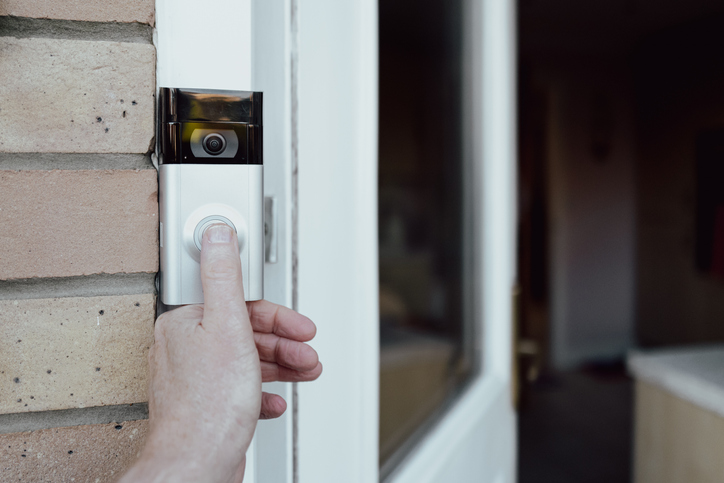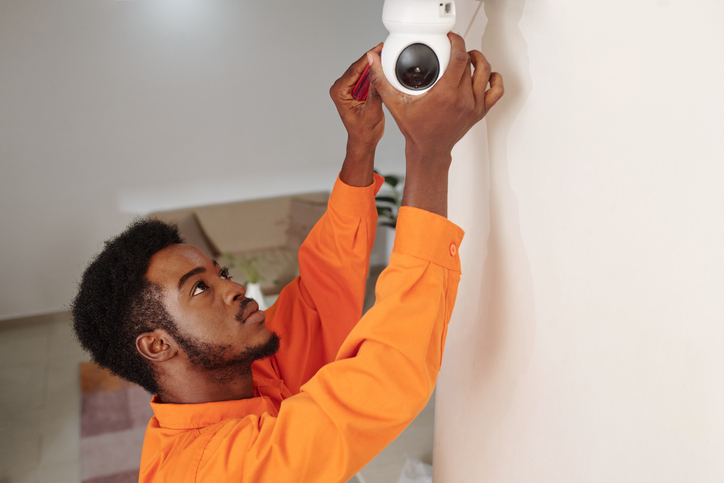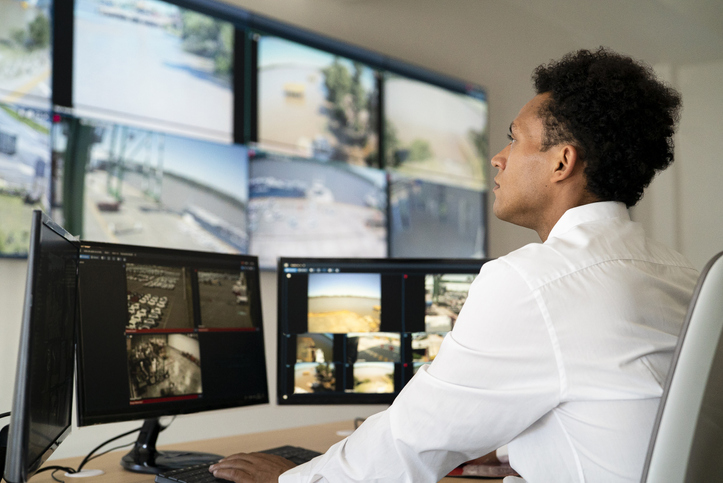Voice-activated home security systems have revolutionized the way we protect and interact with our living spaces. With the power of voice commands, homeowners can now control their security devices effortlessly, ushering in a new era of convenience and innovation. These cutting-edge systems offer a seamless and intuitive experience, allowing users to arm or disarm their security systems, view live camera feeds, and receive instant notifications—all with simple spoken words. In this article, we will delve into the fascinating world of voice-activated home security, exploring how these systems work, their compatibility with popular virtual assistants, and the myriad benefits they bring to modern smart homes. Join us on this journey as we uncover the capabilities, user experiences, and future developments of voice-activated home security, and how it is reshaping the way we protect and secure our most cherished spaces.

Overview Of Activated Home Security
Voice-activated home security systems leverage advanced speech recognition technology to enable homeowners to control and interact with their security devices using voice commands. These systems typically consist of smart home security devices, such as cameras, doorbell cameras, motion sensors, smart locks, and alarms, that are connected to a central hub or a cloud-based platform. The central hub acts as the brain of the system, processing voice commands and sending instructions to the respective devices.
- Overview Of Activated Home Security
- Compatibility With Popular Virtual Assistants
- Benefits Of Using Voice Commands For Home Security
- Exploring The Capabilities Of Voice-Activated Home Security Systems
- Types Of Home Security Systems Controlled With Voice Commands
- Integration With Other Smart Home Devices
- Addressing Security And Privacy Concerns
- Enhancing User Experience And Functionality
- System’s Ability To Recognize Emergency Situations And Respond Appropriately
- Limitations And Future Developments
- Safeguarding Accessibility And Reliability
- Disabling Voice Commands Or Setting Specific Activation Timeframes
- Ongoing Costs Or Subscription Fees Associated With Voice-Activated Home Security
- Conclusion
When a user issues a voice command, the system’s speech recognition software analyzes and interprets the spoken words to understand the intent. Once the command is accurately identified, the system responds by executing the requested action. For instance, a user can say, “Alexa, lock the front door,” and the voice-activated home security system will instruct the smart lock to secure the front door.
The beauty of voice-activated home security lies in its simplicity and convenience. Rather than having to manually interact with an app or a control panel, users can effortlessly manage their security devices with natural language, making it particularly user-friendly for all members of the household, including children and elderly individuals.
Compatibility With Popular Virtual Assistants
Voice-activated home security systems are designed to integrate seamlessly with popular virtual assistants like Amazon’s Alexa and Google Assistant. These virtual assistants act as the intermediary between the user and the security devices, allowing users to control their home security simply by speaking to their preferred virtual assistant.
Integration with virtual assistants offers numerous advantages. First, it expands the range of compatible devices that can be controlled through voice commands. Users can use the same virtual assistant that they use for other smart home devices, streamlining the user experience and centralizing control. Second, virtual assistants often have robust voice recognition capabilities, which enhances the accuracy and responsiveness of voice commands. As virtual assistants continue to evolve and improve, so do the functionality and effectiveness of voice-activated home security systems.
Benefits Of Using Voice Commands For Home Security
One of the most significant benefits of voice-activated home security is the hands-free convenience it offers. Users can interact with their security system from anywhere in their homes without the need to physically access a control panel or a smartphone app. This is especially advantageous when users have their hands full or are in a rush.
commands make home security more accessible to all members of the household, regardless of their age or technological proficiency. Children, elderly individuals, or those with limited mobility can easily manage the security system with simple voice prompts, fostering a sense of empowerment and safety.
Traditional methods of controlling home security systems might involve multiple steps, such as unlocking a phone, opening an app, and navigating to the desired function. With voice commands, users can execute actions quickly and efficiently, potentially reducing response times in emergency situations.
Voice-activated home security systems can be integrated with other smart home devices, such as smart lights and thermostats. This integration enables users to create more sophisticated and automated security routines, such as setting up “away” modes that simultaneously lock doors, arm the security system, and adjust the thermostat to conserve energy.
The hands-free nature of voice-activated commands adds an extra layer of security by minimizing the need for physical interaction with devices. For example, users can ensure that their doors are locked or their security cameras are active without leaving their current location.
Voice-activated technology is a growing trend in the smart home industry. By adopting voice commands for home security, users are embracing the latest advancements in home automation and positioning themselves for future updates and features.
Approximately 61% of smart home device owners in the United States use voice commands through virtual assistants to control their smart home devices, indicating the growing preference for hands-free and convenient control over security and other connected devices in the modern smart home ecosystem.
Exploring The Capabilities Of Voice-Activated Home Security Systems
Voice-activated home security systems have emerged as a revolutionary advancement in the realm of smart home technology. By harnessing the power of voice commands, homeowners can now seamlessly interact with and control various aspects of their home security. This exciting development not only enhances convenience but also fosters a more user-friendly and efficient approach to safeguarding one’s property.
Types Of Home Security Systems Controlled With Voice Commands
Voice-activated home security systems allow users to control and interact with smart cameras using voice commands. Homeowners can request live video feeds from cameras installed inside or outside their property, granting them real-time access to their home’s surroundings. Additionally, they can specify time frames to view recorded footage or receive motion alerts when the cameras detect any movement.
With voice commands, homeowners can harness the power of their smart doorbell cameras. They can instantly access the live video feed from their doorbell camera, enabling them to see and communicate with visitors or delivery personnel from anywhere. Voice-activated doorbell cameras also offer the convenience of providing instructions to guests or couriers when individuals are not physically present at home.
Voice commands enable users to control their smart locks effortlessly. Homeowners can lock or unlock their doors by simply issuing voice prompts, eliminating the need for keys or fumbling with smartphone apps. This feature proves especially valuable when individuals have their hands full or when they need to grant access to others remotely.
Voice-activated systems allow users to manage motion sensors with ease. By using voice commands, homeowners can activate or deactivate these sensors, which play a crucial role in detecting movement and potential intruders within the property. Users can also receive immediate alerts if the motion sensors are triggered, ensuring they stay informed about potential security breaches.
Voice commands provide users with the ability to arm or disarm their security system’s alarms and sirens. This feature adds an additional layer of security, allowing homeowners to control the security status of their property effortlessly.
Integration with smart lighting allows voice-activated systems to control lights throughout the home. Users can use voice commands to turn lights on or off, adjust brightness levels, or even create specific lighting scenes to enhance security. For example, saying “Goodnight” could activate a scene that turns off unnecessary lights and leaves on certain security lights for added safety.
With voice commands, users can access information from environmental sensors integrated into their home security system. They can inquire about indoor temperature, humidity levels, air quality, and even carbon monoxide levels, providing valuable insights into their home’s safety and comfort.
Integration With Other Smart Home Devices
The true power of voice-activated home security systems lies in their ability to seamlessly integrate with other smart home devices, creating a comprehensive and interconnected security ecosystem. By harnessing this integration, homeowners can enjoy enhanced security, convenience, and automation.
Voice-activated systems can be programmed to execute security scenes with a single voice command. These scenes consist of predefined actions that are triggered simultaneously. For instance, saying “Goodnight” could activate a scene that locks all doors, arms the security system, turns off unnecessary lights, and adjusts the thermostat for the night. This integration streamlines daily routines and enhances home security by ensuring that essential security measures are taken consistently.
Integrating voice-activated home security systems with geofencing technology provides an added layer of automation and security. Geofencing allows the system to detect when users leave or approach their home’s vicinity based on their smartphone’s location. When users leave the geofenced area, the system can automatically lock doors, arm the security system, and adjust settings to save energy. Conversely, when users return, it can disarm the system and adjust settings to create a welcoming atmosphere.
Voice-activated systems can manage notifications from various security devices, ensuring that users receive alerts on their preferred devices, such as smartphones or smart speakers. This feature allows homeowners to stay informed about security events in real-time, enhancing their situational awareness.
Integration with cameras and other smart devices enables users to use voice commands for real-time surveillance. Homeowners can effortlessly check camera feeds and monitor their property for any security breaches or suspicious activities while they are away. This feature provides peace of mind, knowing that they can visually verify the security status of their home at any time.
With voice commands, users can control access to their property. They can grant temporary access to visitors, delivery personnel, or house guests through voice-activated entry systems, enhancing security and convenience. For example, users can issue a voice command to remotely unlock the front door for a trusted visitor without needing to physically hand them a key.
Addressing Security And Privacy Concerns
As voice-activated home security systems gain popularity and become an integral part of modern smart homes, ensuring the utmost security and safeguarding user privacy become paramount. These innovative systems offer the convenience of controlling security devices through voice commands, but they also raise legitimate concerns about unauthorized access and data handling.
Measures To Prevent Unauthorized Access To The System
Voice-activated home security systems take security seriously, implementing several measures to prevent unauthorized access to the system and ensure the protection of users’ homes and data. Some of the key security measures employed by these systems include:
Voice-activated systems use advanced voice recognition technology to authenticate users’ voices. Each authorized user’s unique voice profile is stored securely in the system’s database. When a user issues a voice command, the system compares the spoken voice with the stored voice profiles to verify the user’s identity. This ensures that only authorized individuals can control the security devices with voice commands.
In addition to voice recognition, some voice-activated home security systems incorporate multi-factor authentication for added security. This may involve using a PIN, a fingerprint, or a facial recognition scan to verify the user’s identity along with their voice.
All communications between the voice-activated system and the user’s devices, such as smartphones or smart speakers, are encrypted to prevent unauthorized interception or tampering of data.
Voice-activated home security systems often utilize cloud storage to store voice profiles and other sensitive information. These cloud databases are designed with robust security protocols, including encryption and access controls, to safeguard user data from unauthorized access.
To address potential security vulnerabilities, manufacturers of voice-activated home security systems regularly release software updates. These updates patch security flaws and ensure the system remains up-to-date with the latest security measures.
Authorized Users And Potential Intruders With Voice Commands
Ensuring that voice-activated home security systems can differentiate between authorized users and potential intruders is crucial for maintaining the system’s security. Advanced voice recognition technology plays a vital role in achieving this differentiation. Here’s how it works:
During the initial setup, authorized users’ voices are trained and recorded by the system. This process involves speaking specific phrases to create a unique voice profile for each user. As users interact with the system over time, the voice recognition software continually learns and refines its understanding of each user’s voice. This adaptive learning helps improve the accuracy and responsiveness of the system.
In addition to voice patterns, voice-activated home security systems may analyze user behavior and historical usage patterns to further verify the authenticity of a voice command. For instance, if a user typically activates the security system at a certain time each day, the system may cross-reference this behavioral pattern with the voice command for additional validation.
Voice-activated systems incorporate anti-spoofing mechanisms to prevent impersonation attempts using recordings of authorized users’ voices. These mechanisms can detect anomalies in voice patterns and raise alerts if a fraudulent voice command is suspected.
Some voice-activated systems offer the option of combining voice recognition with another form of verification, such as a PIN or biometric scan. This two-factor verification further enhances security and helps prevent unauthorized access.
Privacy Considerations Regarding Data Collection And Storage
As with any technology that collects and processes user data, voice-activated home security systems must address privacy concerns and ensure that user information is handled responsibly.
Manufacturers should be transparent about the data collected by voice-activated systems. Users should be informed about what data is being recorded, how it is used, and whether any data is shared with third parties.
Users should have the option to provide consent for data collection and storage. Additionally, they should be able to opt out of data collection if they are uncomfortable with certain aspects of the system’s functionality.
To protect user privacy, voice-activated systems may use anonymization techniques to dissociate voice recordings from specific individuals. Aggregating data at a higher level can also help protect individual identities while allowing for system improvements based on collective usage patterns.
The system’s cloud storage, where voice profiles and other data are stored, should adhere to industry best practices for data security and encryption. This ensures that user information remains secure from unauthorized access.
Users should have the ability to review, modify, or delete their data stored within the system. Transparent data management policies empower users to have control over their information. Manufacturers should stay compliant with data protection regulations and industry standards to ensure that user data is handled responsibly and ethically.
Enhancing User Experience And Functionality
To enhance the user experience, voice-activated home security systems are equipped with advanced voice recognition technology that can handle different accents, speech variations, and language nuances. Manufacturers invest significant resources in training their voice recognition models to be inclusive and accurately interpret a wide range of voices.
Machine learning algorithms play a vital role in this process. As users interact with the system and issue voice commands, the algorithms continuously learn from the data to improve their accuracy in recognizing diverse speech patterns. This adaptive learning allows the system to better understand and respond to users with varying accents and speech characteristics.
Furthermore, manufacturers conduct extensive testing with users from different regions and linguistic backgrounds to ensure that the voice recognition technology is robust and inclusive. As a result, voice-activated home security systems become accessible and user-friendly for a diverse range of individuals, regardless of their accents or speech variations.
System’s Ability To Recognize Emergency Situations And Respond Appropriately
Voice-activated home security systems are designed to recognize and respond to emergency situations promptly and appropriately. The system’s ability to identify emergency scenarios is critical for ensuring user safety and providing quick assistance when needed. Here’s how these systems achieve this:
Manufacturers program the voice recognition technology to recognize specific emergency keywords or phrases, such as “help,” “emergency,” or “intruder.” When users utter these keywords, the system understands the urgency of the situation and responds accordingly.
Some voice-activated home security systems offer panic commands that trigger immediate responses. For instance, users can issue a panic command like “panic” or “emergency” to activate the alarms, send emergency notifications to preset contacts, and initiate emergency response protocols.
Certain voice-activated systems can directly connect with emergency services, such as police, fire departments, or medical assistance, based on the nature of the emergency. Users can initiate this connection by issuing a voice command or activating a panic feature. Voice-activated systems can also leverage data from environmental sensors, such as smoke detectors or carbon monoxide detectors, to recognize critical emergency situations like fires or gas leaks.
To prevent the accidental triggering of emergency responses, some systems implement verification mechanisms. For example, the system may ask users to confirm the emergency or enter a PIN before initiating emergency protocols.
By efficiently recognizing emergency situations, voice-activated home security systems can take appropriate actions to protect users and their property. The system’s ability to respond swiftly to emergencies contributes to a heightened sense of security, giving homeowners the confidence that their security system is capable of handling critical situations effectively.
Limitations And Future Developments
While voice-activated home security systems offer remarkable advancements, they are not without limitations and challenges. Understanding these aspects is crucial for homeowners considering the adoption of such systems.
Voice recognition technology has come a long way, but it is not yet perfect. Accents, speech variations, background noise, and other environmental factors can occasionally lead to misinterpretation of voice commands, resulting in errors or delays in system response.
In certain situations, voice-activated systems may experience false positives, responding to non-triggering phrases, or false negatives, not recognizing valid commands. These occurrences can impact the overall user experience.
As with any technology, voice-activated systems can be susceptible to security vulnerabilities and potential hacking attempts. Manufacturers must continuously update and fortify the system’s security measures to prevent unauthorized access or data breaches.
Voice-activated home security systems typically rely on internet connectivity to function properly. In the event of an internet outage or disruption, users may experience a temporary loss of functionality.
Storing voice data in the cloud for voice recognition purposes raises privacy concerns for some users. Manufacturers must be transparent about data collection and handling practices to address these concerns.
Safeguarding Accessibility And Reliability
To ensure the utmost accessibility and reliability, voice-activated home security systems are equipped with backup measures to address potential disruptions or malfunctions. These measures provide homeowners with alternative methods of accessing and controlling their security devices in case voice commands encounter issues. Manual overrides serve as a primary backup option, allowing users to control their security system through traditional means, such as physical keypads, mobile apps, or remote controls. Key fobs or remote controls are often included with the system, enabling quick and convenient arming or disarming without relying on voice commands or smartphones.
The presence of keypads near entry points allows users to input a PIN or passcode for system control even if voice commands are temporarily unavailable. Furthermore, some advanced systems incorporate redundant connectivity, such as cellular backup in addition to internet connectivity, ensuring that the system remains functional during internet outages. Additionally, battery backup capabilities come into play during power outages, enabling essential components like cameras, sensors, and alarms to continue operating seamlessly. By offering these backup measures, voice-activated home security systems prioritize accessibility and reliability, empowering users to maintain effective control and protection of their property even under unforeseen circumstances.
Disabling Voice Commands Or Setting Specific Activation Timeframes
Voice-activated home security systems provide homeowners with customizable options to enhance their experience and tailor the system’s behavior according to their preferences and daily routines. One of the key features offered is the ability to temporarily disable voice commands or set specific activation time frames. Scheduled voice commands enable users to pre-program specific actions to occur at designated times. For instance, users can schedule voice commands to automatically arm the security system at bedtime or disarm it when they wake up in the morning. This automation streamlines the security routine, ensuring optimal protection without the need for manual intervention.
A vacation mode feature allows homeowners to activate a temporary suspension of voice commands or apply additional verification steps. This feature proves useful during vacations or extended absences, preventing potential false activations or security issues while the occupants are away. Moreover, some systems offer a do-not-disturb mode, which temporarily silences voice commands during specific hours or when important events are ongoing, ensuring uninterrupted focus and privacy.
Voice command whitelisting allows users to specify authorized individuals whose voices can control the system, preventing unauthorized access. The flexibility to disable voice commands entirely provides users with an option to rely on other interaction methods when voice commands are not preferred or suitable for certain situations. By incorporating these customizable options, voice-activated home security systems empower homeowners with greater control over their security devices, enhancing user experience and flexibility in managing their home’s protection.
Ongoing Costs Or Subscription Fees Associated With Voice-Activated Home Security
When considering the adoption of voice-activated home security systems, homeowners should be aware of the various ongoing costs and potential subscription fees associated with these advanced security solutions. The initial investment typically includes the cost of smart cameras, doorbell cameras, smart locks, and other security devices that support voice commands.
To access advanced features such as video storage and historical data, users may need to subscribe to cloud storage plans offered by the manufacturer. These plans often come with varying storage capacities and involve monthly or annual fees. Some voice-activated systems offer premium features, such as facial recognition, geofencing, or enhanced automation, which might be available through premium subscription plans that come with additional costs.
Users who desire professional monitoring services for round-the-clock security might need to opt for a monthly or yearly subscription. Professional monitoring involves a third-party service that continuously monitors the security system and promptly alerts authorities in case of an emergency. Ongoing firmware updates and customer support services might also be part of the overall subscription package or billed separately.
Homeowners should thoroughly review the pricing structure and any associated subscription fees to make informed decisions based on their budget and desired level of security. Understanding the ongoing costs ensures transparency and enables homeowners to assess the long-term affordability of voice-activated home security systems and their commitment to maintaining a secure and protected living environment.
Conclusion
Voice-activated home security systems are a groundbreaking advancement in smart home technology, offering seamless control through voice commands. Understanding their capabilities, integration with other devices, and user experiences reveals their reliability. Addressing security and privacy concerns ensures user confidence. Enhancing functionality with voice commands, improved recognition, and emergency responses enriches the user experience. While there are limitations, ongoing developments promise to overcome challenges. Safeguarding accessibility and reliability with backups and customization empowers homeowners.




